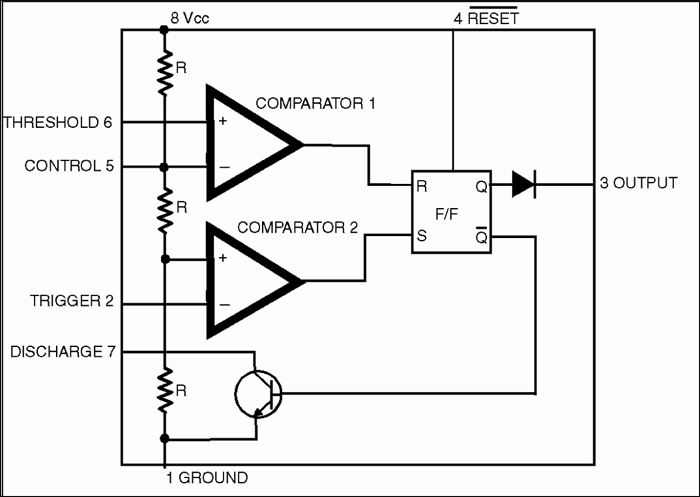This over/under voltage cut-out will save your costly electrical and electronic appliances from the adverse effects of very high and very low mains voltages.
The circuit features auto reset and utilises easily available components. It makes use of the comparators available inside 555 timer ICs. Supply is tapped from different points of the power supply circuit for relay and control circuit operation to achieve reliability.

The circuit utilises comparator 2 for control while comparator 1 output (connected to reset pin R) is kept low by shorting pins 5 and 6 of 555 IC. The positive input pin of comparator 2 is at 1/3rd of Vcc voltage. Thus as long as negative input pin 2 is less positive than 1/3 Vcc, comparator 2 output is high and the internal flip-flop is set, i.e. its Q output (pin 3) is high. At the same time pin 7 is in high impedance state and LED connected to pin 7 is therefore off. The output (at pin 3) reverses (goes low) when pin 2 is taken more positive than 1/3 Vcc. At the same time pin 7 goes low (as Q output of internal flip-flop is high) and the ED connected to pin 7 is lit. Both timers (IC1 and IC2) are configured to function in the same fashion.
Preset VR1 is adjusted for under voltage (say 160 volts) cut-out by observing that LED1 just lights up when mains voltage is slightly greater than 160V AC. At this setting the output at pin 3 of IC1 is low and transistor T1 is in cut-off state. As a result RESET pin 4 of IC2 is held high since it is connected to Vcc via 100 kilo-ohm resistor R4.
Preset VR2 is adjusted for over voltage (say 270V AC) cut-out by observing that LED2 just extinguishes. when the mains voltage is slightly less than 270V AC. With RESET pin 4 of IC2 high, the output pin 3 is also high. As a result transistor T2 conducts and energises relay RL1, connecting load to power supply via its N/O contacts. This is the situation as long as mains voltage is greater than 160V AC but less than 270V AC.

When mains voltage goes beyond 270V AC, it causes output pin 3 of IC2 to go low and cut-off transistor T2 and de-energise relay RL1, in spite of RESET pin 4 still being high. When mains voltage goes below 160V AC, IC1’s pin 3 goes high and LED1 is extinguished. The high output at pin 3 results in conduction of transistor T1. As a result collector of transistor T1 as also RESET pin 4 of IC2 are pulled low. Thus output of IC2 goes low and transistor T2 does not conduct. As a result relay RL1 is de-energised, which causes load to be disconnected from the supply. When mains voltage again goes beyond 160V AC (but less than 270V AC) the relay again energises to connect the load to power supply.







Hello Concern,
Can i get this all material or ready device please contact me
957256137
how can the voltage be monitored if the if the variable inputs to pin 2 is tied to a regulated 9 volts
David, I think He commited an error. VR’s should be connected to the unregulated power supply. This circuit should be perfect if It had a “power-on delay of say….15 sec…another 555 perhaps…
RI IS WRITE AGAIN T2 BASE -GROUND GIVE SUITABLE CAPACIOR TO MAKE SOME DELAY IN ON TIME
HI Gopalakrishna,
I think it is better to connect the out put of the reg 7809 ic for rly coil voltage and the input of reg ic to
the555pin 8and 4for effective voltage sensing.
gentlemen! the circuit does not work. vr1 in vr2 stabilization?
Sambath kumar .
Hi Gopalakrishnan.
I forgot to tell you one thing either change the rly to 9v or change the reg to7812 .As suggested by R1 better to provide a power on delay timer using one more 555 ic .while providing the supply for the ics from the rectified dc provide a 1watt resistor in series tothis supply to safe gaurd the ics.
I have tried to simulate this work ? but it didn’t work? what do I have to change?